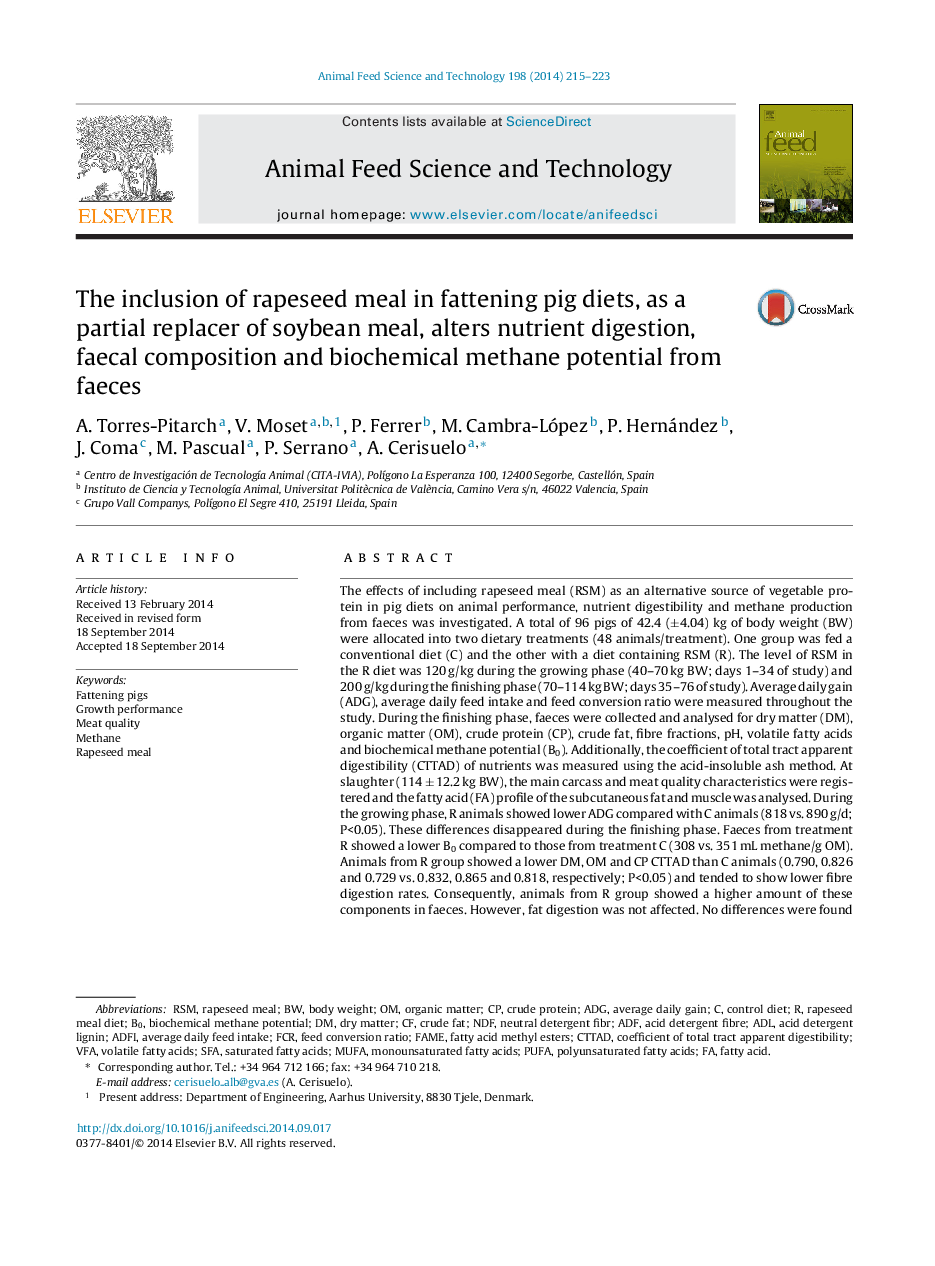| کد مقاله | کد نشریه | سال انتشار | مقاله انگلیسی | نسخه تمام متن |
|---|---|---|---|---|
| 8491520 | 1552387 | 2014 | 9 صفحه PDF | دانلود رایگان |
عنوان انگلیسی مقاله ISI
The inclusion of rapeseed meal in fattening pig diets, as a partial replacer of soybean meal, alters nutrient digestion, faecal composition and biochemical methane potential from faeces
ترجمه فارسی عنوان
گنجاندن وعده های کلزا در رژیم های تغذیه ای خوک، به عنوان یک جایگزین جزئی از وعده های غذایی سویا، باعث تغییر هضم غذا، ترکیب دفع مدفوع و پتانسیل متان های بیوشیمیایی از مدفوع
دانلود مقاله + سفارش ترجمه
دانلود مقاله ISI انگلیسی
رایگان برای ایرانیان
کلمات کلیدی
MUFAADLCTTADNDFSFAADGADFIVFAADFFCRFatty acid - اسید چربPolyunsaturated fatty acids - اسید چرب اشباع نشدهPUFA - اسید چرب چند غیراشباعsaturated fatty acids - اسیدهای چرب اشباع شدهmonounsaturated fatty acids - اسیدهای چرب غیر اشباعVolatile fatty acids - اسیدهای چرب فرارacid detergent fibre - الیاف پاک کننده اسیدFattening pigs - خوک خوکRSM - روششناسی سطح پاسخcontrol diet - رژیم غذایی کنترلcoefficient of total tract apparent digestibility - ضریب هضم ظاهری کل دستگاهGrowth performance - عملکرد رشدacid detergent lignin - لیگنین پاک کننده اسیدorganic matter - ماده آلیdry matter - ماده خشکMethane - متان average daily gain - متوسط افزایش روزانهfatty acid methyl esters - متیل استرهای اسید چربFAME یا fatty acid methyl esters - متیل استرهای اسید چربAverage daily feed intake - میانگین مصرف خوراک روزانهfeed conversion ratio - نسبت تبدیل خوراکbody weight - وزن بدنRapeseed meal - وعده غذایی کلزاbiochemical methane potential - پتانسیل متان بیوشیمیاییcrude protein - پروتئین خامCrude fat - چربی خامMeat quality - کیفیت گوشت
موضوعات مرتبط
علوم زیستی و بیوفناوری
علوم کشاورزی و بیولوژیک
علوم دامی و جانورشناسی
چکیده انگلیسی
The effects of including rapeseed meal (RSM) as an alternative source of vegetable protein in pig diets on animal performance, nutrient digestibility and methane production from faeces was investigated. A total of 96 pigs of 42.4 (±4.04) kg of body weight (BW) were allocated into two dietary treatments (48 animals/treatment). One group was fed a conventional diet (C) and the other with a diet containing RSM (R). The level of RSM in the R diet was 120 g/kg during the growing phase (40-70 kg BW; days 1-34 of study) and 200 g/kg during the finishing phase (70-114 kg BW; days 35-76 of study). Average daily gain (ADG), average daily feed intake and feed conversion ratio were measured throughout the study. During the finishing phase, faeces were collected and analysed for dry matter (DM), organic matter (OM), crude protein (CP), crude fat, fibre fractions, pH, volatile fatty acids and biochemical methane potential (B0). Additionally, the coefficient of total tract apparent digestibility (CTTAD) of nutrients was measured using the acid-insoluble ash method. At slaughter (114 ± 12.2 kg BW), the main carcass and meat quality characteristics were registered and the fatty acid (FA) profile of the subcutaneous fat and muscle was analysed. During the growing phase, R animals showed lower ADG compared with C animals (818 vs. 890 g/d; P<0.05). These differences disappeared during the finishing phase. Faeces from treatment R showed a lower B0 compared to those from treatment C (308 vs. 351 mL methane/g OM). Animals from R group showed a lower DM, OM and CP CTTAD than C animals (0.790, 0.826 and 0.729 vs. 0.832, 0.865 and 0.818, respectively; P<0.05) and tended to show lower fibre digestion rates. Consequently, animals from R group showed a higher amount of these components in faeces. However, fat digestion was not affected. No differences were found between treatments on most carcass characteristics. Overall, the inclusion of high levels of RSM in pig diets decreased final BW and nutrient digestibility (except fat) in the finishing phase. However, faeces from animals fed RSM were less degradable, producing less methane per gram of OM.
ناشر
Database: Elsevier - ScienceDirect (ساینس دایرکت)
Journal: Animal Feed Science and Technology - Volume 198, December 2014, Pages 215-223
Journal: Animal Feed Science and Technology - Volume 198, December 2014, Pages 215-223
نویسندگان
A. Torres-Pitarch, V. Moset, P. Ferrer, M. Cambra-López, P. Hernández, J. Coma, M. Pascual, P. Serrano, A. Cerisuelo,
